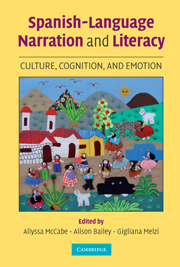Book contents
- Frontmatter
- Contents
- List of Contributors
- Preface
- Acknowledgments
- 1 Introduction
- PART ONE PARENT–CHILD NARRATIVES
- PART TWO DEVELOPING INDEPENDENT NARRATION
- PART THREE NARRATIVE LINKS TO LITERACY AND OTHER SCHOOL ACHIEVEMENTS
- 11 Latino Mothers and Their Preschool Children Talk About the Past: Implications for Language and Literacy
- 12 The Contribution of Spanish-Language Narration to the Assessment of Early Academic Performance of Latino Students
- 13 Cultural Variation in Narrative Competence and Its Implications for Children's Academic Success
- Author Index
- Subject Index
- References
12 - The Contribution of Spanish-Language Narration to the Assessment of Early Academic Performance of Latino Students
Published online by Cambridge University Press: 05 June 2012
- Frontmatter
- Contents
- List of Contributors
- Preface
- Acknowledgments
- 1 Introduction
- PART ONE PARENT–CHILD NARRATIVES
- PART TWO DEVELOPING INDEPENDENT NARRATION
- PART THREE NARRATIVE LINKS TO LITERACY AND OTHER SCHOOL ACHIEVEMENTS
- 11 Latino Mothers and Their Preschool Children Talk About the Past: Implications for Language and Literacy
- 12 The Contribution of Spanish-Language Narration to the Assessment of Early Academic Performance of Latino Students
- 13 Cultural Variation in Narrative Competence and Its Implications for Children's Academic Success
- Author Index
- Subject Index
- References
Summary
Key words: Bilingual education, two-way bilingual programs, school-age children, Spanish-language narration, literacy, academic achievement
ABSTRACT
Evaluations of bilingual programming have largely looked to students' academic performance as the measure of success. This study ascertains the role of Spanish-language narrative abilities in the academic achievement of Spanish-dominant first- through third-grade students, as well as in other developments related to school environments (e.g., attitudes toward school and metalinguistic awareness). Specifically, we asked three questions: (1) What are the Spanish-language narrative abilities of school-age bilingual children?; (2) How do children's Spanish-language and English-language narrative abilities compare?; and (3) What are the relationships between Spanish-language narrative abilities and school achievement, both narrowly and broadly defined? Spanish- and English-language personal narratives were elicited from 20 Spanish-dominant students enrolled in a two-way bilingual program in California. The children came from predominantly low- and middle-income Mexican- and Central American–heritage families. Elicitation prompts included stories about participation in school and their community. Spanish narratives were analyzed at the microstructural level for grammatical accuracy, complexity, and productivity. The macrostructural sophistication of both Spanish and English narratives was examined using highpoint analysis. Results suggest that most of the Spanish narratives were grammatically complex and contained few grammatical errors, but far fewer were as structurally sophisticated as the English-language narratives. Narrative ability was related to measures of students' oral Spanish-language abilities, English-language-arts skills, and level of metapragmatic awareness in English.
- Type
- Chapter
- Information
- Spanish-Language Narration and LiteracyCulture, Cognition, and Emotion, pp. 296 - 331Publisher: Cambridge University PressPrint publication year: 2008
References
- 1
- Cited by



